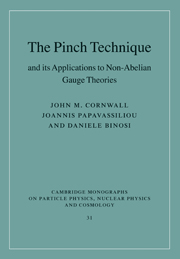Book contents
- Frontmatter
- Contents
- Introduction: Why the pinch technique?
- 1 The pinch technique at one loop
- 2 Advanced pinch technique: Still one loop
- 3 Pinch technique to all orders
- 4 The pinch technique in the Batalin–Vilkovisky framework
- 5 The gauge technique
- 6 Schwinger–Dyson equations in the pinch technique framework
- 7 Nonperturbative gluon mass and quantum solitons
- 8 Nexuses, sphalerons, and fractional topological charge
- 9 A brief summary of d = 3 NAGTs
- 10 The pinch technique for electroweak theory
- 11 Other applications of the pinch technique
- Appendix: Feynman rules
- Index
Introduction: Why the pinch technique?
Published online by Cambridge University Press: 04 February 2011
- Frontmatter
- Contents
- Introduction: Why the pinch technique?
- 1 The pinch technique at one loop
- 2 Advanced pinch technique: Still one loop
- 3 Pinch technique to all orders
- 4 The pinch technique in the Batalin–Vilkovisky framework
- 5 The gauge technique
- 6 Schwinger–Dyson equations in the pinch technique framework
- 7 Nonperturbative gluon mass and quantum solitons
- 8 Nexuses, sphalerons, and fractional topological charge
- 9 A brief summary of d = 3 NAGTs
- 10 The pinch technique for electroweak theory
- 11 Other applications of the pinch technique
- Appendix: Feynman rules
- Index
Summary
Non-Abelian gauge theories (NAGTs) have dominated the world of experimentally accessible particle physics for more than three decades in the form of the standard model with its SU(2) × U(1) (electroweak theory) and SU(3) (quantum chromodynamics: QCD) components. NAGTs are also the ingredients of grand unified theories and technicolor theories and play critical roles in supersymmetry and string theory. It is no wonder that thousands of papers have been written on them. But many of these papers violate the principle of gauge invariance, resulting in calculations of propagators, vertices, and other off-shell form factors that are valid only in the particular gauge chosen. Until these are combined into a gauge-invariant expression, they have very limited, if any, physical meaning. The reason for such violation of gauge invariance is that standard and widely used Feynman graph techniques generate gauge-dependent Green's functions (proper self-energies, three-point vertices, etc.) for the gauge bosons.
Of course, there is one combination of off-shell Green's functions – the on-shell S-matrix – that is gauge invariant no matter which gauge is used for the propagators and vertices that go into it. Thus, authors who (correctly) insist on calculating only gauge-invariant quantities often restrict themselves to dealing only with the S-matrix. This is fine as long as the question at hand can be answered with perturbation theory, but to calculate gauge invariantly a nonperturbative feature using only S-matrix elements is not easy.
- Type
- Chapter
- Information
- Publisher: Cambridge University PressPrint publication year: 2010



